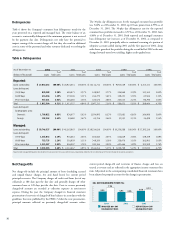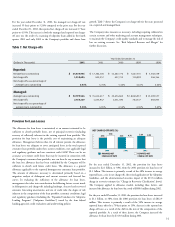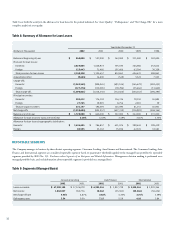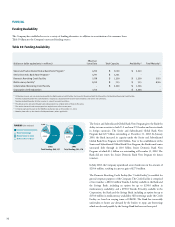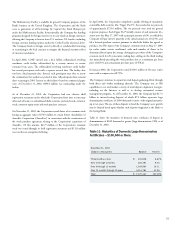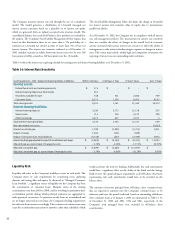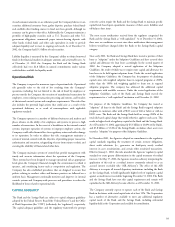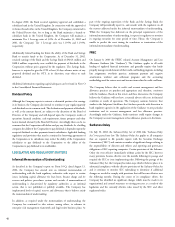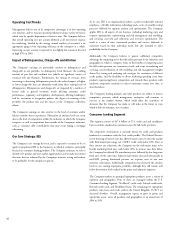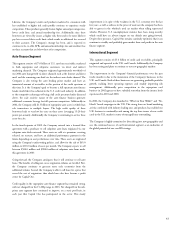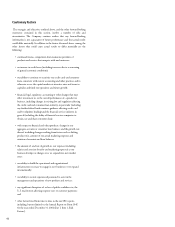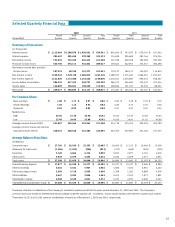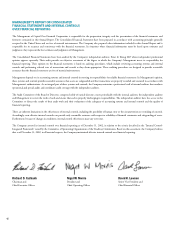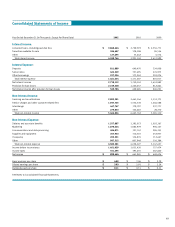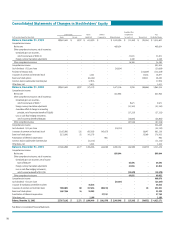Capital One 2002 Annual Report Download - page 42
Download and view the complete annual report
Please find page 42 of the 2002 Capital One annual report below. You can navigate through the pages in the report by either clicking on the pages listed below, or by using the keyword search tool below to find specific information within the annual report.
40
part of the ongoing supervision of the Bank and the Savings Bank, the
Company will periodically report to, and consult with, the regulators on all
the matters addressed under the informal memorandum of understanding.
While the Company has delivered on the principal requirements of the
informal memorandum of understanding, it expects its regulators to monitor
its ongoing execution for some period of time. Hence, the Company is
unable to predict the exact timing for conclusion or termination of the
informal memorandum of understanding.
FFIEC
On January 8, 2003 the FFIEC released Account Management and Loss
Allowance Guidance (the “Guidance”). The Guidance applies to all credit
lending of regulated financial institutions and generally requires that banks
properly manage several elements of their credit-card lending programs, including
line assignments, over-limit practices, minimum payment and negative
amortization, workout and settlement programs and the accounting
methodology used for various assets and income items related to credit card loans.
The Company believes that its credit card account management and loss
allowance practices are prudent and appropriate and, therefore, consistent
with the Guidance. Based on this review and these discussions, the Company
believes the Guidance will not have a material adverse effect on its financial
condition or results of operations. The Company cautions, however, that
similar to the Subprime Guidelines, the Guidance provides wide discretion to
bank regulatory agencies in the application of the Guidance to any particular
institution and its account management and loss allowance practices.
Accordingly, under the Guidance, bank examiners could require changes in
the Company’s account management or loss allowance practices in the future.
Sarbanes-Oxley
On July 30, 2002, the Sarbanes-Oxley Act of 2002 (the “Sarbanes-Oxley
Act”) was passed into law. The Sarbanes-Oxley Act applies to all companies
that are required to file periodic reports with the Securities Exchange
Commission (“SEC”) and contains a number of significant changes relating to
the responsibilities of directors and officers and reporting and governance
obligations of SEC reporting companies. Certain provisions of the Sarbanes-
Oxley Act were effective immediately without action by the SEC; however
many provisions became effective over the months following its passage and
required the SEC to issue implementing rules. Following the passage of the
Sarbanes-Oxley Act, the Company has taken steps which it believes places it in
substantial compliance with the effective provisions of the Sarbanes-Oxley Act
and it continues to monitor SEC rulemaking to determine if additional
changes are needed to comply with provisions that will become effective over
the following months. During the course of its compliance efforts, the
Company has identified no significant changes which must be made to its
organizational and control structures or existing processes as a result of this
legislation and the currently effective rules issued by the SEC and other
regulatory bodies.
In August 2000, the Bank received regulatory approval and established a
subsidiary bank in the United Kingdom. In connection with the approval of
its former branch office in the United Kingdom, the Company committed to
the Federal Reserve that, for so long as the Bank maintains a branch or
subsidiary bank in the United Kingdom, the Company will maintain a
minimum Tier 1 Leverage ratio of 3.0%. As of December 31, 2002 and
2001, the Company’s Tier 1 Leverage ratio was 11.95% and 11.93%,
respectively.
Additionally, federal banking law limits the ability of the Bank and Savings
Bank to transfer funds to the Corporation. As of December 31, 2002,
retained earnings of the Bank and the Savings Bank of $924.4 million and
$408.4 million, respectively, were available for payment of dividends to the
Corporation without prior approval by the regulators. The Savings Bank,
however, is required to give the OTS at least 30 days advance notice of any
proposed dividend and the OTS, in its discretion, may object to such
dividend.
Additional information regarding capital adequacy can be found in Note O
to the Consolidated Financial Statements.
Dividend Policy
Although the Company expects to reinvest a substantial portion of its earnings
in its business, the Company also intends to continue to pay regular quarterly
cash dividends on its common stock. The declaration and payment of dividends,
as well as the amount thereof, are subject to the discretion of the Board of
Directors of the Company and will depend upon the Company’s results of
operations, financial condition, cash requirements, future prospects and other
factors deemed relevant by the Board of Directors. Accordingly, there can be no
assurance that the Corporation will declare and pay any dividends. As a holding
company, the ability of the Corporation to pay dividends is dependent upon the
receipt of dividends or other payments from its subsidiaries. Applicable banking
regulations and provisions that may be contained in borrowing agreements of
the Corporation or its subsidiaries may restrict the ability of the Corporation’s
subsidiaries to pay dividends to the Corporation or the ability of the
Corporation to pay dividends to its stockholders.
LEGISLATIVE AND REGULATORY MATTERS
Informal Memorandum of Understanding
As described in the Company’s report on Form 10-Q, dated August 13,
2002, the Company has entered into an informal memorandum of
understanding with the bank regulatory authorities with respect to certain
issues, including capital, allowance for loan losses, finance charge and fee
reserves and policies, procedures, systems and controls. A memorandum of
understanding is characterized by regulatory authorities as an informal
action, that is not published or publicly available. The Company has
implemented levels of capital, reserves and allowances that it believes satisfy
the memorandum of understanding.
In addition, as required under the memorandum of understanding, the
Company has continued to take actions, among others, to enhance its
enterprise risk management framework and legal entity business plans. As


